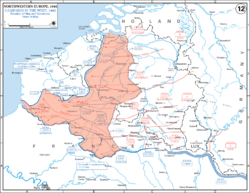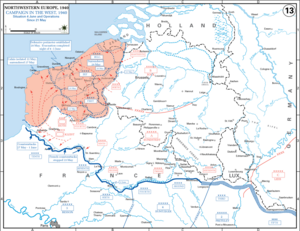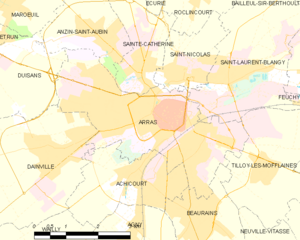Battle of Arras (1940) facts for kids
Quick facts for kids Battle of Arras |
|||||||
|---|---|---|---|---|---|---|---|
| Part of the Battle of France in the Second World War | |||||||
 Situation in France, 21 May 1940. The counter-attack near Arras is seen the centre-left of the image. |
|||||||
|
|||||||
| Belligerents | |||||||
| Commanders and leaders | |||||||
| Units involved | |||||||
| 3e Division Légère Mécanique 5th Infantry Division 50th Motor Division |
SS Division Totenkopf 5th Panzer Division 7th Panzer Division |
||||||
| Strength | |||||||
| 74 tanks 15,000 infantry |
c. 225 tanks 5,000–10,000 infantry |
||||||
| Casualties and losses | |||||||
| 74 tanks destroyed c. 500 British killed, wounded, and captured |
350 killed or wounded, 400 captured 7th Panzer Division lost 37 tanks |
||||||
The Battle of Arras happened on May 21, 1940, during the Battle of France in World War II. German forces had invaded the Low Countries (like Belgium and the Netherlands) on May 10. French and British troops moved into Belgium to stop them.
The German plan was to trick the Allies into thinking the main attack was in Belgium. But the real main attack came through the Ardennes forest. German tanks quickly crossed the Meuse river. Instead of waiting, they pushed towards the English Channel.
The Allies were confused. Their attempts to stop the fast German tanks were disorganized. The main Allied armies were stuck in Belgium. The attack at Arras was planned by the British and French. It aimed to help the British troops in Arras. This attack was not fully coordinated with other French attacks from the south.
The British and French had limited forces. They launched a small attack with tanks and infantry south from Arras. The Allies gained some ground early on. They even caused panic among some German units. But after advancing about 10 km (6.2 mi), they had to pull back. They retreated after dark to avoid being surrounded.
Even though the attack failed, it had a big effect on Adolf Hitler and the German high command. They worried about more Allied attacks against their tank corridor. This made Hitler order the tanks to stop. They waited until the situation at Arras was stable again.
The Allies used this pause to strengthen the Channel Ports. This stopped the Germans from capturing them quickly. They also fortified the areas near Dunkirk. This pause made the evacuation of British and French forces possible. This famous evacuation was called Operation Dynamo.
Contents
Background to the Battle
The Battle of France Begins
The German Army Group A defeated the French at the Battle of Sedan. This happened from May 12 to 15, allowing them to cross the Meuse river. A French counter-attack on May 17 was defeated. This attack was led by Colonel Charles de Gaulle. German air support also played a big role.
German forces then broke through gaps in the Allied lines. They threatened cities like Boulogne and Calais. This cut off the Allied armies in northern France and Belgium. On May 19, General Edmund Ironside, a British commander, met with Lord Gort. Lord Gort was the commander of the British Expeditionary Force (BEF). Ironside urged Gort to attack south towards Amiens. But Gort only had two divisions ready for an attack.
On May 20, General Maurice Gamelin, the French commander, ordered the trapped armies to fight their way south. They were supposed to link up with French forces attacking north. But the French Prime Minister, Paul Reynaud, replaced Gamelin with General Maxime Weygand. Weygand then ordered a similar counter-offensive. This attack would come from both the north and south. It aimed to break the German "corridor" and free the surrounded armies.
In the north, the British combined their available troops. They formed a group called Frankforce. This force was to hold the Scarpe river line east of Arras. They would also attack south of Arras. The French also planned an attack north from the Somme river.
King Leopold III of Belgium told Lord Gort that he did not expect the BEF to risk itself. He warned that if the British continued their southern attack, the Belgians would be in trouble. Leopold suggested that the Allies should instead create a safe area around Dunkirk. The BEF still sent more troops to Arras.
Getting Ready for Battle
German Advance
The German 7th Panzer Division had captured Cambrai. They then moved to the area south of Arras. On May 21, they were ordered to move west around Arras. Their goal was to attack north and capture crossings over the Scarpe river. This was a risky move. Their right side would be open to an attack from Arras.
The 5th Panzer Division was supposed to help. But they were delayed and never reached their positions. General Erwin Rommel, leading the 7th Panzer Division, sent his tanks ahead. He later returned to find his infantry under attack by Allied tanks and soldiers.
Allied Preparations
The French Air Force was supposed to support the British attack. But they received no details about the attack. They didn't know where or when to attack. French reconnaissance planes were shot down or chased away.
Major-General Harold Franklyn led the British Frankforce. This force was made up of his 5th Infantry Division. It also included the 50th Motor Division and 74 tanks. Frankforce moved near Vimy, north of Arras. Their goal was to reinforce Arras and counter-attack south. They wanted to cut German supply lines. Franklyn did not know about a French attack from the south. The French also didn't know about the British attack.
Franklyn had some support from French tanks. But many French tanks had been destroyed in earlier battles. By May 21, only a few tanks from the 3rd Light Mechanized Division could help. The attack was meant to have two French and two British infantry divisions. But Frankforce only had about 15,000 men. Many were used for defense.
The attacking force was small. It had about 2,000 men and 74 tanks. The tanks included 58 Matilda Is. These had thick armor but only a machine gun. There were also 16 Matilda II tanks. These were very well armored and had a powerful 2-pounder gun.
Allied Plan
Franklyn's original orders were to plan a small attack south of Arras. This was to help the troops in the town. But more ambitious plans for a combined attack were not shared with him. Franklyn used most of his force for defense.
The plan was for the 151st Infantry Brigade to advance from west of Arras. They would move towards the Cojeul River. The 13th Infantry Brigade would then cross the river. They would advance south from east of Arras to meet the 151st Brigade.
Two main columns were formed. The Right Column had tanks and infantry. The Left Column also had tanks and infantry. They were to start their attack around 2:00 p.m. The infantry had to march about 8 mi (13 km) to reach their starting points. The roads were full of traffic and refugees, making it difficult.
The Battle Unfolds
French Tanks Join In
A French tank advance was also poorly prepared. There was not enough communication with the British. The French didn't know the British attack time or direction. There was even some accidental firing between French and British forces. A British anti-tank gun was destroyed.
Later that evening, the French force, with about six tanks, fought German tanks south of Duisans. British troops were retreating. By the time German tanks broke through, the British had escaped.
Right Column's Fight
The infantry had little time to prepare for the attack. They had to march through roads full of refugees. The Right Column started its advance at 2:30 p.m. They immediately faced small-arms fire. They fought through Duisans, which was held by German infantry. They also reported German tanks to their west.
After leaving troops to guard Duisans, the column captured Warlus. They faced strong resistance there. They also captured Berneville to the south. A small group pushed on to the Arras–Doullens road. There, they met German infantry and SS troops.
The British were forced to take cover by machine-gun and mortar fire. German planes attacked the Right Column for twenty minutes. Dive-bombers attacked British forces. The British tanks kept going. They reached Wailly, where they met more German troops. The advanced British troops suffered many losses. They retreated to Warlus. German tanks then counter-attacked Warlus and Duisans. The German attacks were pushed back. But they cut the road between the villages. The Right Column could not advance further.
Left Column's Fight
The Left Column also met resistance right away. They fought through German troops at Dainville. About 2 mi (3.2 km) further, at Achicourt, six Matilda tanks overran German anti-tank guns. The column continued to Agny and Beaurains. A group reached Wancourt on the Cojeul river.
Infantry held Agny and Beaurains. The 4th Royal Tank Regiment pushed back German tank counter-attacks. They also fought German infantry on the right side of the 7th Panzer Division. The British then took ground south of Beaurains. Fighting continued all afternoon. The tanks ran into a line of anti-aircraft guns and artillery. This included powerful 88 mm Flak guns. Many British tanks were destroyed. Individual tanks kept going. But there were no reserve troops to help. The advance stopped after heavy fighting.
East of Arras, the 150th Infantry Brigade attacked across the Scarpe river. The 13th Infantry Brigade captured a bridgehead further east. This was in preparation for the second part of the attack.
German 7th Panzer Division's Experience
German infantry was attacked by a British column advancing from Dainville. Several German vehicles were destroyed. More British tanks attacked from the north. They caught German convoys spread out on the road. The German 42nd Anti-Tank Battalion was rushed to the area. But it was overrun by the British tanks.
After breaking through the German infantry, the British tanks attacked German transport. They then pushed on, causing confusion among the German SS troops. They almost overran the SS headquarters. When the British tanks broke through the German anti-tank defenses, the German infantry held their ground. General Rommel encouraged them, even after British tanks rolled over their anti-tank guns.
Around 4:00 p.m., about 40 British tanks attacked. German 88 mm Flak guns destroyed several Matilda I tanks. But some larger Matilda II tanks advanced through the artillery fire without damage. German shells bounced off their thick armor. These tanks destroyed the German anti-tank guns. They rolled over them, killing the crews. The British tanks were finally stopped by another artillery battery. But other tanks bypassed the area. On the southern side of the 7th Panzer Division, SS troops were attacked and some fled in panic.
Allied Retreat
The British advanced about 10 mi (16 km) at most. They took 400 German prisoners. Many German tanks and equipment were destroyed. But two Matilda II tanks were also knocked out. Only 26 Matilda Is were still working. Both British tank battalion commanders were killed. That evening, Franklyn ordered both columns to pull back.
French cavalry remained near Warlus. They were surrounded during the night. Only a few tanks managed to escape. The British infantry in Warlus were rescued by six French tanks. These tanks broke through the German positions. The troops in Duisans also retreated after dark. They were covered by anti-tank guns. The Left Column troops in Agny and Beaurains were bombed. Then they were attacked by tanks as they retreated. The 7th Panzer Division camped overnight south of Dainville.
After the Battle
Losses
General Rommel wrote in his diary that his division lost 89 men killed, 116 wounded, and 173 missing or captured. This was as many losses as the first four days of the invasion. British records show about 400 Germans were taken prisoner. The British lost about 100 men killed or wounded. The number of French casualties is not known. Frankforce lost sixty of its 88 tanks during the attack.
Later Operations
The main French attack on Cambrai happened on May 22. Like the Arras attack, it was much smaller than planned. The French attack reached the edge of Cambrai. But it was stopped by German air attacks and forced to retreat.
Halt Orders
The Allied counter-attack at Arras had a big effect on the Germans. Their commanders were worried about their exposed flanks. General Ewald von Kleist, a German tank commander, saw a "serious threat." He told his superiors that he had to wait until the crisis was over. General Günther von Kluge also ordered the tanks to stop.
On May 22, after the attack was pushed back, the German high command ordered that the situation at Arras must be fixed. Only then could the tanks move on to Boulogne and Calais. Hitler himself ordered all mobile units to operate around Arras.
The German commanders at the front realized the real danger. The Allies might retreat to the coast too quickly. So, a race for the Channel ports began. German tanks were ordered to capture Boulogne, Calais, and Dunkirk. Most of the British and French armies were still far from the coast. But British troops were sent from England to Boulogne and Calais just in time. They arrived before the German tanks on May 22.
Some historians believe that if the German tanks had not stopped for 24 hours after the Battle of Arras, Boulogne and Calais would have fallen. If there had been no halts, Dunkirk might have been captured by the Germans already. This would have made the Allied evacuation much harder.
Remembering the Battle
The battle honor Defence of Arras was given to the British units who fought in this counter-attack.
See also
- List of British military equipment of World War II
- List of French military equipment of World War II
- List of German military equipment of World War II
Images for kids







